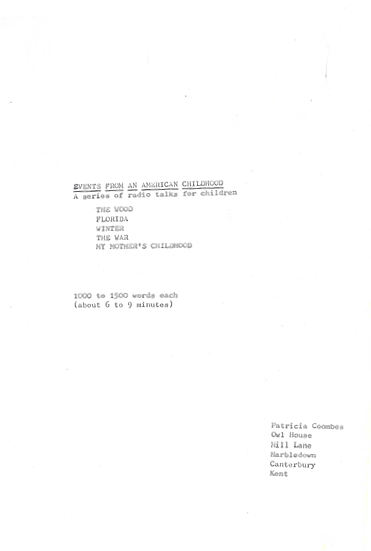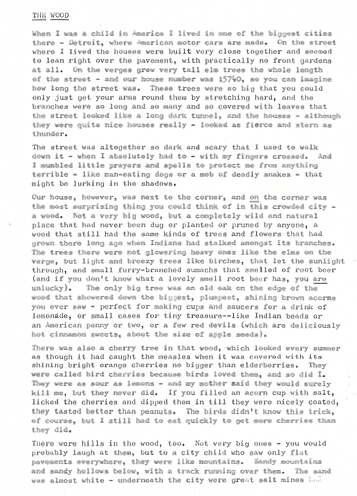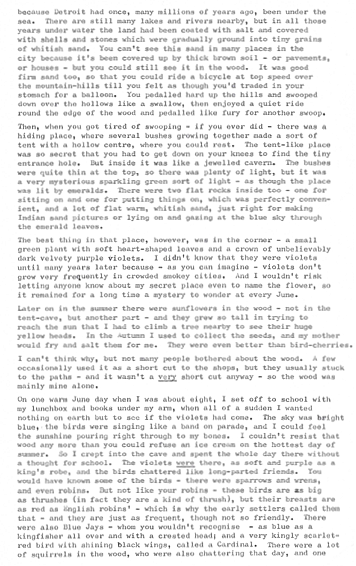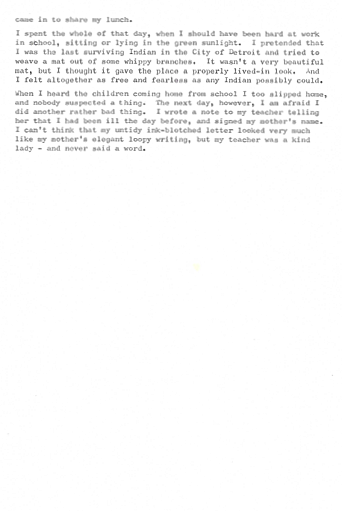At the end of her inspiring webinar on working with children in a woodland setting, Sue Coombes mentioned that she had a story written by her mum, entitled The Wood. It’s about her time growing up in Detroit, discovering a wild wood, eating bird cherries dipped in salt and skipping school to see the violets! Here it is in its original form and converted into text:




EVENTS FROM AN AMERICAN CHILDHOOD
Patricia Coombes, Owl House, Mill Lane, Harbledown, Canterbury, Kent
THE WOOD
When I was a child in America I lived in one of the biggest cities there – Detroit, where American motor cars are made. On the street where I lived the houses were built very close together and seemed to lean right over the pavement, with practically no front gardens at all. On the verges grew very tall elm trees the whole length of the street and our house number was 15740, so you can imagine how long the street was. These trees were so big that you could only just get your arms round them by stretching hard, and the branches were so long and so many and so covered with leaves that the street looked like a long dark tunnel, and the houses although they were quite nice houses really looked as fierce and stern as thunder.
The street was altogether so dark and scary that I used to walk down it when I absolutely had to with my fingers crossed. And I mumbled little prayers and spells to protect me from anything terrible like man-eating dogs or a mob of deadly snakes that might be lurking in the shadows.
Our house, however, was next to the corner, and on the corner was the most surprising thing you could think of in this crowded city – a wood. Not a very big wood, but a completely wild and natural place that had never been dug or planted or pruned by anyone, a wood that still had the same kinds of trees and flowers that had grown there long ago when Indians had stalked amongst its branches. The trees there were not glowering heavy ones like the elms on the verge, but light and breezy trees like birches, that let the sunlight through, and small furry-branched sumachs that smelled of root beer (and if you don’t know what a lovely smell root beer has, you are unlucky). The only big tree was an old oak on the edge of the wood that showered down the biggest, plumpest, shining brown acorns you ever saw perfect for making cups and saucers for a drink of lemonade, or small cases for tiny treasure–like Indian beads or an American penny or two, or a few red devils (which are deliciously hot cinnamon sweets, about the size of apple seeds).
There was also a cherry tree in that wood, which looked every summer as though it had caught the measles when it was covered with its shining bright orange cherries no bigger than elderberries. They were called bird cherries because birds loved them, and so did I. They were as sour as lemons and my mother said they would surely kill me, but they never did. If you filled an acorn cup with salt, licked the cherries and dipped them in till they were nicely coated, they tasted better than peanuts. The birds didn’t know this trick, of course, but I still had to eat quickly to get more cherries than they did.
There were hills in the wood, too. Not very big ones you would probably laugh at them, but to a city child who saw only flat pavements everywhere, they were like mountains. Sandy mountains and sandy hollows below, with a track running over them. The sand was almost white – underneath the city were great salt mines because Detroit had once, many millions of years ago, been under the sea. There are still many lakes and rivers nearby, but in all those years under water the land had been coated with salt and covered with shells and stones which were gradually ground into tiny grains of whitish sand. You can’t see this sand in many places in the city because it’s been covered up by thick brown soil or pavements, or houses but you could still see it in the wood. It was good firm sand too, so that you could ride a bicycle at top speed over the mountain-hills till you felt as though you’d traded in your stomach for a balloon. You pedalled hard up the hills and swooped down over the hollows like a swallow, then enjoyed a quiet ride round the edge of the wood and pedalled like fury for another swoop.
Then, when you got tired of swooping if you ever did there was a hiding place, where several bushes growing together made a sort of tent with a hollow centre, where you could rest. The tent-like place was so secret that you had to get down on your knees to find the tiny entrance hole. But inside it was like a jewelled cavern. The bushes were quite thin at the top, so there was plenty of light, but it was a very mysterious sparkling green sort of light as though the place was lit by emeralds. There were two flat rocks inside too – one for sitting on and one for putting things on, which was perfectly convenient, and a lot of flat warm, whitish sand, just right for making Indian sand pictures or lying on and gazing at the blue sky through the emerald leaves.
The best thing in that place, however, was in the corner a small green plant with soft heart-shaped leaves and a crown of unbelievably dark velvety purple violets. I didn’t know that they were violets until many years later because as you can imagine violets don’t grow very frequently in crowded smokey cities. And I wouldn’t risk letting anyone know about my secret place even to name the flower, so it remained for a long time a mystery to wonder at every June.
Later on in the summer there were sunflowers in the wood – not in the tent-cave, but another part and they grew so tall in trying to reach the sun that I had to climb a tree nearby to see their huge yellow heads. In the Autumn I used to collect the seeds, and my mother would fry and salt them for me. They were even better than bird-cherries.
I can’t think why, but not many people bothered about the wood. A few occasionally used it as a short cut to the shops, but they usually stuck to the paths and it wasn’t a very short cut anyway so the wood was mainly mine alone.
On one warm June day when I was about eight, I set off to school with my lunchbox and books under my arm, when all of a sudden I wanted nothing on earth but to see if the violets had come. The sky was bright blue, the birds were singing like a band on parade, and I could feel the sunshine pouring right through to my bones. I couldn’t resist that wood any more than you could refuse an ice cream on the hottest day of summer. So I crept into the cave and spent the whole day there without a thought for school. The violets were there, as soft and purple as a king’s robe, and the birds chattered like long-parted friends. You would have known some of the birds there were sparrows and wrens, and even robins. But not like your robins these birds are as big as thrushes (in fact they are a kind of thrush), but their breasts are as red as English robins which is why the early settlers called them that and they are just as frequent, though not so friendly. There were also Blue Jays whom you wouldn’t recognise as blue as a kingfisher all over and with a crested head; and a very kingly scarlet-red bird with shining black wings, called a Cardinal. There were a lot of squirrels in the wood, who were also chattering that day, and one came in to share my lunch.
I spent the whole of that day, when I should have been hard at work in school, sitting or lying in the green sunlight. I pretended that I was the last surviving Indian in the City of Detroit and tried to weave a mat out of some whippy branches. It wasn’t a very beautiful mat, but I thought it gave the place a properly lived-in look. And I felt altogether as free and fearless as any Indian possibly could.
When I heard the children coming home from school I too slipped home, and nobody suspected a thing. The next day, however, I am afraid I did another rather bad thing. I wrote a note to my teacher telling her that I had been ill the day before, and signed my mother’s name. I can’t think that my untidy ink-blotched letter looked very much like my mother’s elegant loopy writing, but my teacher was a kind lady and never said a word.

Patricia Coombes (dark hair) with her mother and younger sister.

